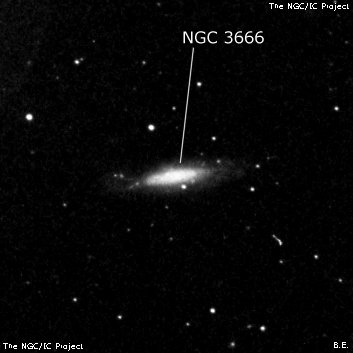
William Herschel discovered NGC 3666 = H I-20 = h882 on 15 Mar 1784 (sweep 174) and noted "E, r. A vB star may be taken into the field with it." CH's reduced position is 10 tsec following UGC 6420. JH observed it on 3 sweeps, first noting on sweep 242 "eF; 2nd or 3rd class. The bright star 1341 A.S.C. follows it. This neb must have changed greatly if it ever belonged really to the 1st class [as place by WH]."
Winnecke wrote a paper in 1879 (AN 2293) claiming this nebula displayed "periodic variability". As "proof" Winnecke mentions William Herschel placed this nebula in his first class of "Bright Nebula", but John Herschel called it "eF, 2nd or 3rd class." Winnecke described it as "pretty bright", while d'Arrest in 1863 termed it "subobscura". Dreyer found it barely visible in 1887 with the 10-inch Grubb refractor at Armagh but in 1891 he it appeared bright.
Dreyer was critical of reports of variability of nebulae in general and commented in a 1891 paper that "this is a diffused nebula with a very slight central condensation" and "the appearance of objects of this kind is far more influenced by the state of our atmosphere than that of nebulae with a distinct condensation." Wolfgang Steinicke discusses this cases on page 519 of his book on the history of the NGC.
300/350mm - 13.1" (4/10/86): fairly faint, elongated ~E-W, bright core, sharper light cut off on the east side. A mag 14 star is 1.5' NNE of center. Located 9' SW of mag 5.8 SAO 99598.
Notes by Steve Gottlieb